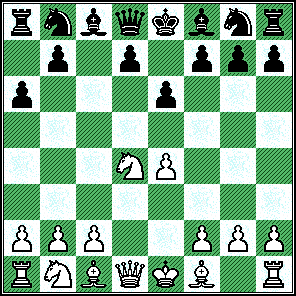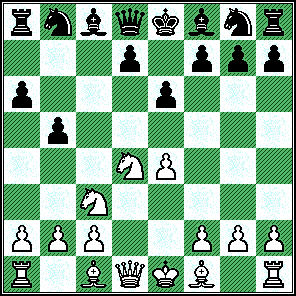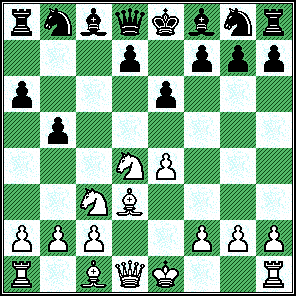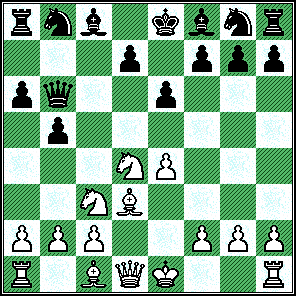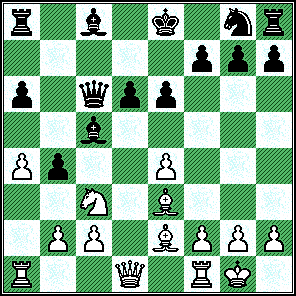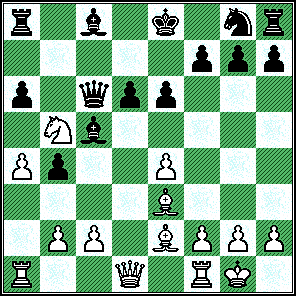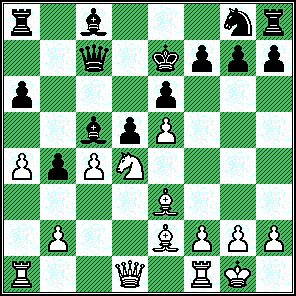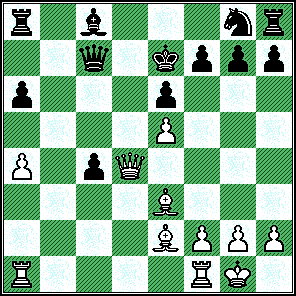IM
Andrei Volokitin (2638) - GM
Vadim Malakhatko (2555)
|
|
|
*********************
It has been used by many GM's over the years. Players who have used this system are: V. Smyslov, L. Portisch, G. Kamsky, V. Ivanchuk, V. Topalov, Sergei Rublevsky, and Peter Svidler. Also Judit Polgar has used it on occasion as well.
This system was also featured in the
games of the new (FIDE) World
Champion, GM R. Kasimdzhanov.
{See the match that he played with
GM Michael Adams in the finals of
FIDE's K.O. event in Tripoli, Libya.}
(If you are interested, you can go to
my "Down-Loads" web site
and get
all of these games - annotated -
for free.)
[ The moves of:
4...Nc6;
5.Nc3, {Diagram?}
leads to ... The Taimanov
System.
[ See MCO-14, beginning on
page 300. ] ]
5.Nc3,
A simple, strong and good
developing move, but Bd3 is also
very playable here - and used to be the
main line as well.
(Additionally, White can also play 5.c2-c4, "+/=" in this position.)
[ Also played is the line:
5.Bd3 Nf6;
{Diagram?}
A solid and very playable move.
(Black also plays ...Knight-to-c6; and
...Bishop-to-the-c5-square; in this position.)
*** *** *** *** ***
*** *** *** *** ***
*** *** *** *** ***
*** *** *** *** ***
*** *** ***
( A very famous game
... ... ... is the following contest:
5...Nc6!?; 6.Nxc6 bxc6; 7.0-0 d5;
8.c4! Nf6!?; 9.cxd5 cxd5;
10.exd5 exd5!?;
{Diagram?}
In this position, the isolated Pawn
is just too weak. (Maybe - '?!')
( Better was: >/= 10...Nxd5!, "~" {Diag?} with a decent position for Black. )
11.Nc3 Be7;
12.Qa4+! Qd7?!; 13.Re1!!, {Diagram?}
Retaining a positional superiority
- - with absolutely no risk.
( Both Bobby Fischer and the
{former} World Champ felt that
after White
won the exchange
with the moves: (</=) 13.Bb5!? axb5; 14.Qxa8, '±'
{D?}
Black might gain needed play. )
13...Qxa4; 14.Nxa4 Be6; 15.Be3! 0-0;
16.Bc5!, "+/=" {Diagram?}
White had a very large and plain
positional superiority ('±') and
went on to win without
too much
trouble from here.
GM R. Fischer - GM Petrosian; /
(FIDE) Candidates Match {Game
# 07}
Buenos Aires, ARG; 1971.
{1-0 in 34 simple, very beautiful
moves. And Black never had
even one ounce of real
or
meaningful counter-play!} )
*** *** *** *** *** *** *** *** *** *** *** *** *** *** *** *** *** *** *** *** *** *** ***
(Returning to the main line
from MCO here.)
6.0-0 d6; 7.c4 Be7; 8.Nc3 0-0;
9.Qe2!? Nbd7; 10.f4 Qc7; 11.Kh1 b6;
12.Bd2 g6!?;
{Diagram?}
The end of the column here.
13.Rac1 Bb7; 14.b4!? Rac8;
15.a3 Qb8; 16.Nf3,
"+/=" {Diagram?}
White has a very solid edge in
the given position here. (Maybe - '±')
IM Kim Commons - GM Miguel Najdorf;
ICT / Masters Open (swiss) /
Lone Pine, CA / USA; 1976.
[ See MCO-14, page # 309; column # 01, and also note # (f.). ] ]
5...b5!?;
(hmmm)
{See the diagram
- - just below.}
This is a super-sharp and a very
dangerous move ...
that seems to
be the height of current opening
fashion at the master level today.
*********************
|
|
*********************
So far ... White has developed two
pieces. All Black has done is push
Pawns. And it is White to move!
(Is the second player taunting his
opponent here? Is this some sort of
'psyche job' opening?
A ... "Come
and get me!" type attitude?)
[ Maybe better would be for Black to transpose to a less-sharp line, that seems to be less risky.
For example:
(>/=) "=" 5...Nc6;
6.Be2 Qc7; 7.0-0 Nf6; 8.Be3 Be7;
9.f4 d6; 10.Qe1,
"+/=" {Diagram?}
White has a small, solid edge
... but several GM games confirm that
the second player's position is
both playable and durable.
GM Joel Lautier - GM Josif Dorfman;
The National Champ. Tournament
/
Val d'lsere, France; 2004.
{This game was eventually drawn
in 43 tough moves.}
*************************************************************
*************************************************************
Black can also play ...Qc7 here.
For example:
5...Qc7; 6.Bd3,
{Diagram?}
Using my largest reference db,
this is one of the most popular
moves for White, here.
{Statistically speaking.}
** ** ** ** ** ** ** ** ** ** ** ** ** ** ** ** ** ** ** ** ** ** ** ** ** ** ** ** ** **
( White can also play the following
continuation from this position:
6.Be2 b5!?; 7.0-0 Bb7; 8.Re1 Nc6; 9.Nxc6 dxc6!?;
10.e5!? Ne7;
11.Bd3 Rd8; 12.Bg5!? h6; 13.Qh5!? Rd7; {Diagram?}
The end of the line/row here.
14.a4 b4; 15.Ne4, "+/=" {Diagram?}
White has a small but secure
edge in this position.
GM Gata Kamsky (2655) -
GM Christopher Lutz (2550);
ICT / Masters (Invitational) (Round # 7) / Dortmund, GER; 1993.
{The game was drawn in 35 moves.}
[ See "Nunn's Chess Opening's,"
(NCO); by GM John Nunn.
Page # 185, Line/row # 07;
and also all notes, and especially
consult note # 30. ] )
** ** ** ** ** ** ** ** ** ** ** ** ** ** ** ** ** ** ** ** ** ** ** ** ** ** ** ** ** **
(Returning to the main line of
or analysis here.)
6...Nc6;
{Diagram?}
One of the more popular choices
for Black in this position, at least
according to the database.
************************************************************************
--->
( One respected reference work
gives another continuation here:
"=" 6...Nf6; 7.0-0,
{Diagram?}
Sound, steady and solid.
*** *** *** *** *** *** *** *** *** *** *** *** *** *** *** *** *** ***
(
For the continuation of: </= 7.Qe2!? b5!?; ('?!'/'?')
{Diagram?}
see the 'Bonus
Game' for
this month. (September, 2004.)
GM E. Sutovsky - GM A. Kunte; / ICT, Master's / Pune, IND; 2004. )
*** *** *** *** *** *** *** *** *** *** *** *** *** *** *** *** *** ***
(Returning to the MCO line here.)
7...d6; 8.f4 Nbd7;
9.Kh1 Be7; 10.Qe2 0-0;
11.Bd2 g6!?; 12.Rae1!?,
"+/=" {Diagram?}
White is solidly better.
GM V. Jansa - FM P. Dankert;
/
ICT / 2nd Wichern Open /
Hamburg, GER; 1993.
[ See MCO-14, page # 312;
column # 07,
and also all the
notes, # (a.) through note # (d.). ] )
<---
************************************************************************
(Returning to the main path of
our analysis line here.)
7.Be3 Nf6; 8.0-0 Ne5!?;
9.h3!?, "~" ("+/=")
{Diagram?}
White is probably just a little
bit better in this position.
** ** ** ** ** ** ** ** ** ** ** ** ** **
I found nearly 1200 games in the
database, but the following would
definitely be one of my favorites:
GM Mikhail Tal - GM Vereslav S. Eingorn;
/
ICT / Masters (Invitational)
Sochi, U.S.S.R;
1986.
{This game was eventually
drawn in around 40 moves.}
*****
--->
See also the contest:
GM Garry Kasparov - GM Viswanathan Anand;
ICT / Masters (Inv.)
/
Tilburg, NED; 1991.
{1-0, in 29 crisp moves.} ]
6.Bd3,
{See the diagram ... just below.}
A sharp - but solid reply ...
that is designed to reinforce White's control of the center.
*********************
|
|
*********************
Now White has THREE pieces developed ... to his opponent's none!
[ Interesting and playable is:
6.a3!?,
"+/=" {Diagram?}
and White keeps a small and
very solid advantage here.
However several GM games have
clearly demonstrated that Black
is probably OK
here.
For example: GM L. Yurtaev - GM V.
Bologan;
The 58th URS Championships
/
Moscow, Russia; 1991.
{This game was drawn ... without
any great difficulties by Black.} ]
**********************************************************
6...Qb6!?;
{See the diagram - just below.}
A very provocative move ... that is
also a 'book' line. However, this
sharp Queen move looks too
"anti-positional" and non-developing
to me, to be of any real or lasting
value.
*********************
|
|
*********************
This move was first played ...
in the following meeting:
S. Sahu - E. Vasiukov;
Coimbatore, 1987.
(It {eventually} resulted in a
victory for the first player.)
[ Maybe better would be:
(>/=) 6...b4!?; 7.Nce2 Bb7;
8.Ng3 Qc7; 9.0-0 Nf6;
10.Qe2, "+/=" {Diagram?}
and White keeps a solid edge.
{However, this is a definite
improvement over what actually
occurred in the game here.}
(I found no master-level games with this position in the database.)
********************************************************
One very respected reference work
gives the following continuation here:
(>/=) 6...Bb7!?;
7.0-0 Ne7!?; 8.Re1!? Nbc6; 9.Nxc6!? Bxc6!?;
10.Bg5!? f6!?; 11.Bh4!? Ng6; 12.Qh5 Be7;
{Diagram?}
The end of the column here.
13.a4!? bxa4; 14.Nxa4 0-0;
15.Bg3, {Diagram?}
(The first player has) "a distinct
advantage" in this position.
- GM Nick de Firmian
GM J. Stocek - GM A. Gipslis;
ICT / Masters Open
/
Pardubice, CZE; 1995.
{This game was drawn in 42
overall moves.}
[ See MCO-14, page # 312; column # 10, and note # (n.). ] ]
White's next move appears to
be the most natural response to
the second player's last move.
7.Be3 Bc5;
Black's last move seems relatively
reasonable ... to retreat would be an obvious loss of time.
(Now according to the on-line
database for CB, most players use the move Nce2 for White
in this
particular position.)
8.Be2!,
This is the most solid and positionally
correct method here.
(Other moves
for White in this position do not seem
to yield the best results.)
It might seem to be a contradiction
to retreat the Bishop here - but
apparently this move, clearing the
d-file for White, is the best way to
meet the problems posed by Black's
last two moves.
*******
[ White could also try:
8.Qg4!? Bxd4!?;
('?!') {Diagram?}
It is not clear how Black should
defend this position.
( Maybe Black should play:
>/= 8...g6!?; 9.e5!, "+/=" {Diag?}
to avoid losing material. )
9.e5! Bxe3; 10.Qxg7! Bxf2+;
11.Kf1!, "+/=" {Diagram?}
White appears to be winning material.
Nonetheless, in the contest:
GM Joe Gallagher - GM Vadim Milov;
ICT / Masters & GM's /
Biel, SUI; 2000. (1/2, 81
moves);
White was unable to win a very
long and difficult game.
Now ...Bh4; g3, Bb7!; etc.
*********************************************************
*********************************************************
Apparently, the move of Nce2 is
also good enough for a small
advantage for White here. For example:
8.Nce2 Nf6; 9.c3 Ng4; 10.Ng3!?,
{Diagram?}
Not entirely convincing ...
( >/= 10.b4! Be7; 11.Qd2, "+/=" )
10...Nxe3; 11.fxe3 g6?!;
12.e5 Bb7!?; 13.Ne4 Bxe4; 14.Bxe4 Ra7;
15.Qf3 d5; 16.exd6 0-0; 17.0-0,
"+/=" {Diagram?}
and White went on to win a
fairly convincing battle in only
thirty-five total
moves.
GM Sergei Fedorchuk (2564) -
GM Edvins Kengis (2570);
ICT / AIG Life / rapid / qf1 (5) /
Warsaw, POL; 22,12,2002. ]
*******
Both sides continue to develop.
8...d6;
(TN?) {Diagram?}
While seemingly a solid move ...
this move could be new to theory.
And judging by the results here ...
maybe it was best left unplayed!
[ Maybe a slight improvement
(for Black) would be:
>/= 8...Nc6; 9.Nxc6 Bxe3;
10.fxe3 dxc6; 11.Qd4 Qxd4;
12.exd4,
"+/=" {Diagram?}
when White has a slight edge,
but it is not nearly so big as in
the actual game.
GM Peter Svidler - GM Vadim Milov;
ICT / Ordix Open
/
Frankfurt, GER; 2000.
{White won, 1-0, in 64 moves.} ]
9.0-0 Nc6;
10.Nxc6 Qxc6; 11.a4! b4!?; (inferior?)
{See
the diagram - just below.}
At a first glance, this appears to
be the correct reaction for Black.
However upon deeper thought,
perhaps this was a dubious
approach for Black in this position.
*********************
|
|
*********************
At this point ... it would be easy to assume that Black has no real problems in this game.
[ Maybe Black should have tried
the following continuation:
(>/=) 11...bxa4!?;
12.Bxc5 Qxc5; 13.Nxa4 Qc6; 14.Qd3 Nf6;
15.Bf3 e5!; 16.Rfd1,
"+/=" {Diagram?}
White has solid edge, (Maybe - '±');
but there is no clear, forced win
from here. ]
12.Nb5!!,
(Wheee!!) {See
the diagram ... just below.}
The fun begins!!
*********************
|
|
*********************
Needless to say, this is an amazing move to be able to play. Obviously Black cannot immediately capture, but we keep expecting White to have to {eventually} retreat ... but when he finally does, Volokitin has virtually a won game.
[ Not as convincing would be:
</= 12.Bxc5 Qxc5;
13.Na2, "+/=" {Diagram?}
and White is only just a tiny bit
better in this position. ]
12...Ke7;
{Box?}
(hmmm)
Black logically tries to defend
his dark squares.
(Of course the move of ...PxN/b5??;
is completely wrong because of the
response of simply BxP/b5, pinning
and winning the Black Queen.)
*******
[
Variation # 12B01.)
After the continuation:
"="
12...Nf6!?; 13.Bxc5 Qxc5; 14.Qxd6 Qxd6;
15.Nxd6+ Ke7; 16.e5 Ne8;
17.Nc4, '±' {Diagram?}
White appears to have simply
won a Pawn and probably has
a won
endgame, even with best
play.
*************************************************************
Variation # 12B02.)
</= 12...Qxe4??;
13.Bxc5!, {Diagram?}
This is probably best.
( The move 13.Nc7+, also wins. )
13...Qe5;
{Diagram?}
The box says this is forced.
( </= 13...dxc5??; 14.Nd6+. {Royal fork!} )
14.Nxd6+ Ke7; 15.Bxb4,
("+/-") {Diagram?}
and Black could resign.
]
*******
13.e5! d5;
{Box?}
This is close to being forced for
Black in this position ...
naturally
the defender would want to close
lines here.
[ Black could not play:
</= 13...dxe5?;
14.Bf3 Qb6; {Diagram?}
If Black pushes the Pawn, to
the e4-square, White simply
takes it with the Bishop.
15.Bxa8,
("+/-") {Diagram?}
and Black's position is simply
horrible. (I.e., lost.) ]
14.Nd4 Qc7!?;
15.c4!, {See the diagram ... just
below.}
White immediately rips open
lines to his opponent's King.
*********************
|
|
*********************
Black cannot capture the hanging button on e5, due to the Knight fork on the c6-square.
[ Also good was: 15.Rc1, '±' {Diagram?} and White is clearly on top. ]
15...bxc3;
16.Rc1 Bb4; {Box?}
This appears to be pretty much
forced ... all the tactics work in
White's favor.
(This is because
the first player is so far ahead in development.)
[ It is a mistake to open more lines in this position.
For example: </=
16...cxb2?; 17.Rxc5! Qd7;
{Diagram?}
This looks to be forced.
( Not </= 17...Qxc5??; 18.Nf5+, and Black loses the Queen here. )
18.Qc2!,
("+/-") {Diagram?}
White's position is winning ...
completely overwhelming here. ]
17.bxc3!?,
(Maybe - '!')
This is good, White plans to use
his a-Rook to play against the
Queen on the c-file here.
[ Also very good was:
(>/=) 17.Qb3!?,
('!') '±' {Diagram?}
and White is close to winning.
]
17...Ba3;
18.Ra1 Bc5[]; {Box?}
This looks virtually forced.
[ Clearly worse was:
</= 18...Bb2?!;
19.Ra2 Bxc3;
20.Rc2, "+/-"
{Diagram?}
and the pin on the c-file
will cost Black material. ]
19.c4! Bxd4;
20.Qxd4 dxc4; {See the diagram
- just below here.}
Black's position is truly wretched.
(And probably already lost.)
*********************
|
|
*********************
Don't believe me? Then have a look for yourself here!
************************************************************************************
************************************************************************************
Now Rab1!! might win by force. (Fritz finds this after like just a few minutes of machine time here.)
What Volokitin plays is also
sufficient to win.
21.Rac1! f6!?;
22.Rxc4!? Qxe5; 23.Qxe5!? fxe5; 24.Bf3!, ("+/-")
Black Resigns.
After the forced move, ...Rb8;
White win material, (At least a
whole piece.); with Ba7.
--->
So Black hangs it up.
A nice game by a talented youth.
Winning the Championship of the
Ukraine at such an age promises
a very bright
future for this player.
**************
Copyright (c) A.J. Goldsby, 2004. All rights reserved.
1 - 0
(HTML code, initially) Generated with ChessBase 8.0
All the diagrams on this page, were generated with the excellent little program, Chess_Captor 2.25.
